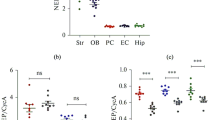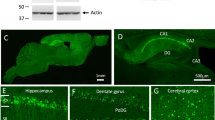Abstract
In the present study, in modeling the pathogenesis of Alzheimer’s disease in 5xFAD transgenic mice, a comparative analysis of structural and ultrastructural changes in the nervous tissue of the olfactory bulbs, hippocampus, and entorhinal cortex was performed; in addition, the distribution of the main amyloid-degrading neuropeptidase, neprilysin (NEP), relative to wild-type mice was examined. The investigation of the structure of the nervous tissue showed that the death of brain neurons increased in transgenic animals characterized by increased production of the amyloid peptide Aβ. As a result, connections between neurons were interrupted and the neural network become disrupted. Our electron-microscopy examination revealed a reduced density of synaptic contacts and dendritic spines, local lesions of the nervous tissue, and the appearance of autophagolysosomes in the neuropil tissue of these structures in 5xFAD mice. Signs indicating increased neurodegenerative processes compared with wild-type mice were visible. In 5xFAD mice, the distribution of amyloid-degrading peptidase NEP in the entorhinal cortex and hippocampus was altered, and there was a decreased intensity of its staining in the entorhinal cortex. In transgenic mice aged 6 months, memory impairment was observed in the recognition test of new objects relative to wild-type mice.






Similar content being viewed by others
REFERENCES
Antunes, M. and Biala, G., The novel object recognition memory: neurobiology, test procedure, and its modifications, Cogn. Process., 2021, vol. 13, p. 93. http://doi.org/10.1007/s10339-011-0430-z
Cai, Y., Xue, Z.Q., Zhang, X.M., Li, M.B., Wang, H., Luo, X.G., Cai, H., and Yan, X.X., An age-related axon terminal pathology around the first olfactory relay that involves amyloidogenic protein overexpression without plaque formation, Neuroscience, 2012, vol. 215, p. 160. http://doi.org/10.1016/j.neuroscience.2012.04.043
Cohen, C.J. and Stackman, R.W., Jr., Assessing rodent hippocampal involvement in the novel object recognition task. A review, Behav. Brain Res., 2015, vol. 285, p. 105. http://doi.org/10.1016/j.bbr.2014.08.002
Devi, L. and Ohno, M., Phospho-eIF2α level is important for determining abilities of BACE1 reduction to rescue cholinergic neurodegeneration and memory defects in 5XFAD mice, PLoS One, 2010b, vol. 5, article ID e12974. http://doi.org/10.1371/journal.pone.0012974
Devi, L., Alldred, M.J., Ginsberg, S.D., and Ohno, M., Sex- and brain region-specific acceleration of β-amyloidogenesis following behavioral stress in a mouse model of Alzheimer’s disease, Mol. Brain, 2010a, vol. 3, p. 34. http://doi.org/10.1186/1756-6606-3-34
Eimer, W.A. and Vassar, R., Neuron loss in the 5XFAD mouse model of Alzheimer’s disease correlates with intraneuronal Abeta42 accumulation and Caspase-3 activation, Mol. Neurodegener., 2013, vol. 8, p. 2. http://doi.org/10.1186/1750-1326-8-2
Fisk, L., Nalivaeva, N.N., Boyle, J.P., Peers, C.S., and Turner, A.J., Effects of hypoxia and oxidative stress on expression of neprilysin in human neuroblastoma cells and rat cortical neurones and astrocytes, Neurochem. Res., 2007, vol. 32, p. 1741. http://doi.org/10.1007/s11064-007-9349-2
Gaudel, F., Stephan, D., Landel, V., Sicard, G., Féron, F., and Guiraudie-Capraz, G., Expression of the cerebral olfactory receptors Olfr110/111 and Olfr544 is altered during aging and in Alzheimer’s disease-like mice, Mol. Neurobiol., 2018, vol. 56, p. 2057. http://doi.org/10.1007/s12035-018-1196-4
Hammond, R.S., Tull, L.E., and Stackman, R.W., On the delay-dependent involvement of the hippocampus in object recognition memory, Neurobiol. Learn. Mem., 2004, vol. 82, p. 26. http://doi.org/10.1016/j.nlm.2004.03.005
Hüttenrauch, M., Baches, S., Gerth, J., Bayer, T.A., Weggen, S., and Wirths, O., Neprilysin deficiency alters the neuropathological and behavioral phenotype in the 5XFAD mouse model of Alzheimer’s disease, J. Alzheimers Dis., 2015, vol. 44, p. 1291 http://doi.org/10.3233/JAD-142463
Kanno, T., Tsuchiya, A., and Nishizaki, T., Hyperphosphorylation of Tau at Ser396 occurs in the much earlier stage than appearance of learning and memory disorders in 5XFAD mice, Behav. Brain Res., 2014, vol. 274, p. 302. http://doi.org/10.1016/j.bbr.2014.08.034
Kimura, R. and Ohno, M., Impairments in remote memory stabilization precede hippocampal synaptic and cognitive failures in 5XFAD Alzheimer mouse model, Neurobiol. Dis., 2009, vol. 33, p. 229. http://doi.org/10.1016/j.nbd.2008.10.006
Lane, C.A., Hardy, J., and Schott, J.M., Alzheimer’s disease, Eur. J. Neurol., 2018, vol. 25, p. 59. http://doi.org/10.1111/ene.13439
Maarouf, C.L., Kokjohn, T.A., Whiteside, C.M., Ma-cias, M.P., Kalback, W.M., Sabbagh, M.N., Beach, T.G, Vassar, R., and Roher, A.E., Molecular differences and similarities between Alzheimer’s disease and the 5XFAD transgenic mouse model of amyloidosis, Biochem. Insights, 2013, vol. 6, p. 1. http://doi.org/10.4137/BCI.S13025
Melnik, S.A., Gladysheva, O.S., and Krylov, V.N., Age-related changes in the olfactory sensitivity of male mice to the smell of isovaleric acid, Sens. Sist., 2009, vol. 23, p. 151.
Mirzaei, N., Tang, S.P., Ashworth, S., Coello, C., Plisson, C., Passchier, J., Selvaraj, V., Tyacke, R.J., Nutt, D.J., and Sastre, M., In vivo imaging of microglial activation by positron emission tomography with [(11)C]PBR28 in the 5XFAD model of Alzheimer’s disease, Glia, 2016, vol. 64, p. 993. http://doi.org/10.1002/glia.22978
Murphy, C., Olfactory and other sensory impairments in Alzheimer disease, Nat. Rev. Neurol., 2019, vol. 15, p. 11. https://doi.org/10.1038/s41582-018-0097-5
Nalivaeva, N.N. and Turner, A.J., Targeting amyloid clearance in Alzheimer’s disease as a therapeutic strategy, Br. J. Pharmacol., 2019, vol. 176, p. 3447. https://doi.org/10.1111/bph.14593
Nalivaeva, N.N., Zhuravin, I.A., and Turner, A.J., Neprilysin expression and functions in development, ageing and disease, Mech. Ageing Dev., 2020a, vol. 192, p. 111363. http://doi.org/10.1016/j.mad.2020.111363
Nalivaeva, N.N., Vasilev, D.S., Dubrovskaya, N.M., Turner, A.J., and Zhuravin, I.A., Role of neprilysin in synaptic plasticity and memory, Ross. Fiziol. Zh. im. I.M. Sechenova, 2020b, vol. 106, p. 1191. https://doi.org/10.31857/S0869813920100076
Neuman, K.M., Molina-Campos, E., Musial, T.F., Price, A.L., Oh, K.J., Wolke, M.L., Buss, E.W., Scheff, S.W., Mufson, E.J., and Nicholson, D.A., Evidence for Alzheimer’s disease-linked synapse loss and compensation in mouse and human hippocampal CA1 pyramidal neurons, Brain Struct. Funct., 2015, vol. 220, p. 3143. http://doi.org/10.1007/s00429-014-0848-z
Nocera, S., Simon A., Fiquet, O., Chen, Y., Gascuel, J., Datiche, F., Schneider, N., Epelbaum, J., and Viollet, C., Somatostatin serves a modulatory role in the mouse olfactory bulb: neuroanatomical and behavioral evidence, Front. Behav. Neurosci., 2019, vol. 13, p. 61. https://doi.org/10.3389/fnbeh.2019.00061
O’Leary, T.P., Stover, K.R., Mantolino, H.M., Darvesh, S., and Brown, R.E., Intact olfactory memory in the 5xFAD mouse model of Alzheimer’s disease from 3 to 15 months of age, Behav. Brain Res., 2020, vol. 393, p. 112731. http://doi.org/10.1016/j.bbr.2020.112731
Oakley, H.O., Cole, S.L., Logan, S., Maus, E., Shao, P., Craft, J., Guillozet-Bongaarts, A., Ohno, M., Disterhoft, J., Van Eldik, L., Berry, R., and Vassar, R., Intraneuronal β-amyloid aggregates, neurodegeneration, and neuron loss in transgenic mice with five familial Alzheimer’s disease mutations: potential factors in amyloid plaque formation, J. Neurosci., 2006, vol. 26, p. 10129. https://doi.org/10.1523/JNEUROSCI.1202-06.2006
Ohno, M., Cole, S.L., Yasvoina, M., Zhao, J., Citron, M., Berry, R., Disterhoft, J.F., and Vassar, R., BACE1 gene deletion prevents neuron loss and memory deficits in 5XFAD APP/PS1 transgenic mice, Neurobiol. Dis., 2007, vol. 26, p. 134. http://doi.org/10.1016/j.nbd.2006.12.008
Park, S.W., Im, S., Jun, H.O., Lee, K., Park, Y.J., Kim, J.H., Park, W.J., Lee, Y.H., and Kim, J.H., Dry age-related macular degeneration like pathology in aged 5XFAD mice: ultrastructure and microarray analysis, Oncotarget, 2017, vol. 8, p. 40006. http://doi.org/10.18632/oncotarget.16967
Paxinos, G. and Franklin, K.B.J., The Mouse Brain in Stereotaxic Coordinates, San Diego: Academic, 2001, 2nd ed.
Reddy, P.H. and Oliver, D.M., Amyloid β and phosphorylated tau-induced defective autophagy and mitophagy in Alzheimer’s disease, Cells, 2019, vol. 8, p. 488. http://doi.org/10.3390/cells8050488
Roddick, K.M., Roberts, A.D., Schellinck, H.M., and Brown, R.E., Sex and genotype differences in odor detection in the 3×Tg-AD and 5XFAD mouse models of Alzheimer’s disease at 6 months of age, Chem. Senses, 2016, vol. 41, p. 433. http://doi.org/10.1093/chemse/bjw018
Saiz-Sanchez, D., Ubeda-Bañon, I., de la Rosa-Prieto, C., Argandoña-Palacios, L., Garcia-Muñozguren, S., Insausti, R., and Martinez-Marcos, A., Somatostatin, tau, and β-amyloid within the anterior olfactory nucleus in Alzheimer disease, Exp. Neurol., 2010, vol. 223, p. 347. http://doi.org/10.1016/j.expneurol.2009.06.010
Shao, C.Y., Mirra, S.S., Sait, H.B., Sacktor, T.C., and Sigurdsson, E.M., Postsynaptic degeneration as revealed by PSD-95 reduction occurs after advanced Aβ and tau pathology in transgenic mouse models of Alzheimer’s disease, Acta Neuropathol. 2011, vol. 122, p. 285. http://doi.org/10.1007/s00401-011-0843-x
Tumanova, N.L., Vasilev, D.S., Dubrovskaya, N.M., and Zhuravin, I.A., Ultrastructural alterations in the sensorimotor cortex upon delayed development of motor behavior in early ontogenesis of rats exposed to prenatal hypoxia, Cell Tissue Biol., 2018, vol. 12, no. 5, p. 419. https://doi.org/10.31116/tsitol.2018.05.09
Tumanova, N.L., Vasilev, D.S., Dubrovskaya, N.M., Nalivaeva, N.N., and Zhuravin, I.A., Effect of prenatal hypoxia on cytoarchitectonics and ultrustructural organisation of brain regions related to olfaction in rats, Tsitologiia, 2021, vol. 15, no. 5, p. 482. http://doi.org/10.31857/S0041377121020085
Vasilev, D.S., Dubrovskaya, N.M., Zhuravin, I.A., and Nalivaeva, N.N., Developmental profile of brain neprilysin expression correlates with olfactory behaviour of rats, J. Mol. Neurosci., 2021, vol. 71, p. 1772. http://doi.org/10.1007/s12031-020-01786-3
Wang, C., Telpoukhovskaia, M.A., Bahr, B.A., Chen, X., and Gan, L., Endo-lysosomal dysfunction: a converging mechanism in neurodegenerative diseases, Curr. Opin. Neurobiol., 2018, vol. 48, p. 52. http://doi.org/10.1016/j.conb.2017.09.005
Yang, Z., Kuboyama, T., and Tohda, C., A systematic strategy for discovering a therapeutic drug for Alzheimer’s disease and its target molecule, Front. Pharmacol., 2017, vol. 8, p. 340. http://doi.org/10.3389/fphar.2017.00340
ACKNOWLEDGMENTS
The authors express their deep gratitude to the Center for Collective Use of Scientific Equipment for Physiological, Biochemical, and Molecular Biological Research of the Sechenov Institute of Evolutionary Physiology and Biochemistry, Russian Academy of Sciences.
Funding
This work was supported by the Russian Foundation for Basic Research (project no. 19-015-00232) and partly by a state order to the Sechenov Institute of Evolutionary Physiology and Biochemistry, Russian Academy of Sciences (no. AAAA-A18-118012290373-7).
Author information
Authors and Affiliations
Contributions
N.L. Tumanova, morphological studies, article writing; D.S. Vasiliev, morphological and immunohistochemical assay, statistical data processing; N.M. Dubrovskaya, behavioral experiments and statistical processing of data; N.N. Nalivaeva, data analysis, writing and editing the text of the article, general management of the work. The text and images are approved by all coauthors.
Corresponding author
Ethics declarations
Conflict of interest. The authors declare that they have no conflicts of interest.
Statement on the welfare of animals. Experiments with animals were carried out in accordance with the approved protocol for the use of laboratory animals of the Sechenov Institute of Evolutionary Physiology and Biochemistry, Russian Academy of Sciences, on the basis of European Communities Council Directive no. 86/609 for the Care of Laboratory Animals.
Additional information
Translated by I. Fridlyanskaya
Abbreviations: APP—β-amyloid peptide precursor, AD—Alzheimer’s disease, Aβ—β-amyloid peptide, PS1—presenilin 1, EPR—endoplasmic reticulum.
Rights and permissions
About this article
Cite this article
Tumanova, N.L., Vasiliev, D.S., Dubrovskaya, N.M. et al. Morphofunctional Changes in the Brain Nervous Tissue of 5xFAD Transgenic Mice. Cell Tiss. Biol. 16, 380–391 (2022). https://doi.org/10.1134/S1990519X22040095
Received:
Revised:
Accepted:
Published:
Issue Date:
DOI: https://doi.org/10.1134/S1990519X22040095




